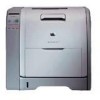HP 3500 HP Color LaserJet 3500 and 3700 Series Printers - User Guide - Page 167
Issue, Cause, Solution, HP specifications. See
 |
View all HP 3500 manuals
Add to My Manuals
Save this manual to your list of manuals |
Page 167 highlights
ENWW Issue Common causes of paper jams1 Cause Solution Paper does not meet HPrecommended paper specifications. Use only paper that meets HP specifications. See Supported paper weights and sizes. A supply item is installed incorrectly, causing repeated jams. Verify that all print cartridges, the transfer unit, and the fuser are correctly installed. You are reloading paper that has already passed through a printer or copier. Do not use paper that has been previously printed on or copied. An input tray is loaded incorrectly. Remove any excess paper from the input tray. Be sure that the paper does not exceed the maximum stack height mark in the input tray. See Configuring trays. Paper is skewed. Input tray guides are not adjusted correctly. Adjust input tray guides so they hold paper firmly in place without bending it. Paper is binding or sticking together. Remove paper, flex it, rotate it 180 degrees, or flip it over. Reload paper into the input tray. Note Do not fan paper. Fanning can create static electricity, which can cause paper to stick together. Paper is removed before it settles into the output bin. Reset the printer. Wait until the page completely settles in the output bin before removing it. When duplexing, the paper is removed before the second side of the document is printed. Reset the printer and print the document again. Wait until the page completely settles in the output bin before removing it. Paper is in poor condition. Replace the paper. Paper is not picked up by the internal rollers from Tray 2 or Tray 3. Remove the top sheet of paper. If the paper is heavier than 163 g/m2 (43 lb), it may not be picked from the tray. Paper has rough or jagged edges. Replace the paper. Paper is perforated or embossed. This paper does not separate easily. You might need to feed single sheets from Tray 1. Common causes of paper jams 155















